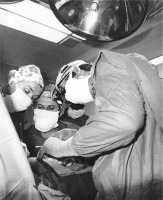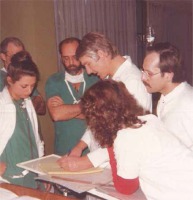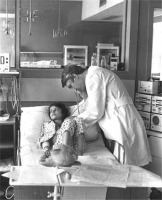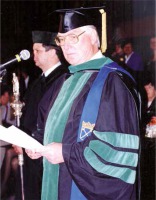With deep regret and sorrow we are bidding farewell to a great human being: the world-renowned pediatric cardiac surgeon, William Imon Norwood, an academic and an ingenious master of surgery of the heart. Words of farewell are offered by us, cardiac surgeons from Krakow and the whole of Poland together with pediatric cardiac surgeons from all corners of the world. Everywhere where pediatric cardiac surgeons are active, on all continents, everywhere where physicians care for newborns with severe cardiac defects, the name of this great virtuoso of surgical techniques is well known and uttered with awe and respect. His output and innovative solutions have distinctly and permanently affected the development of cardiac surgery. The Norwood procedure he devised is quintessential among his lifetime achievements, being an accomplishment resulting from several decades of development. Today the procedure is an indicator of the mode of functioning of a cardiac surgical centre, thus placing high demands on medical teams.
Professor Norwood graduated from public school in Los Alamos in 1959; there his father, a scientist, William Norwood Senior, was employed and worked on the Manhattan Project. Having completed his high school education, William I. Norwood commenced schooling in the Air Force Academy. However, 2 years later, he dropped out of school. In the years 1960–1966, he studied medicine at the University of Colorado. In the period 1967/1968, he was a surgical resident in the university centre in Minneapolis, Minnesota, a place that was famous for pioneering achievements in the early years of world cardiac surgery. Somewhat earlier, in the 1950s, it was there that ground-breaking operations employing cross-circulation were performed, and history was made by Richard Varco and C. Walton Lillehei.
Having completed his residency in general surgery, Professor Norwood continued his education in managing acquired and congenital heart defects in Harvard University teaching hospitals – in the famous Peter Bent Brigham Hospital in Boston and in Boston Children’s Hospital, where he completed his residency as the chief resident in 1976 and his supervisor was Professor Aldo Castańeda. In the years 1976–1983, he was employed by Boston Children’s Hospital as a member of Professor Castańeda’s team and a member of the Medical Faculty of Harvard University. It was then that he became interested in the most severe congenital heart defects in newborns, including hypoplastic left heart syndrome. At the time, children with the defect had no chance of survival whatsoever. The then Dr. Norwood devised and performed numerous novel surgical procedures, developing operative techniques employed in managing the most complex, lethal heart defects. It was also at that time, when working with a charity foundation named Project Hope, that he started coming to Poland, to the Polish-American Institute of Pediatrics in Krakow. As a young, extremely efficient, and experienced cardiac surgeon he started implementing an extensive plan aiming at organising and developing pediatric cardiac surgery in Krakow. Assisted by a team of American physicians and nurses, employing instruments they brought from the US (which were unique to the situation in Poland at that time) on May 31, 1977, Dr. Norwood performed in Krakow the first open heart cardiopulmonary bypass surgery (Figures 1–4). The following year he initiated, in the same institution, surgical treatment with the use of deep hypothermia with circulatory arrest; later the same year, he performed Poland’s first Fontan procedure in a child with a single ventricle. Also in 1978, he initiated in Krakow corrective procedures in transposition of the great arteries using the Senning operation and employing anatomical correction almost simultaneously.
Figure 1
During the first surgery, May 31, 1977. On the right – Professor William Norwood, in the centre – Janusz Skalski, on the left – Professor Eugenia Zdebska

Figure 3
Discussing the medications for a child in the Institute of Pediatrics in Krakow (1977), from the left – Eugenia Zdebska, American nurse, William Norwood (from the Archives of Project Hope)

Figure 4
Discussing the plan of surgery in the Institute of Pediatrics in Krakow (1977), from the left – Janusz Skalski, William Norwood, Robert Kettrick (an anesthesiologist), other members of the American team (from the Archives of Project Hope)

In the period from 1984 to 1994, he was Chief of the university pediatric cardiac surgery centre in the Children’s Hospital of Philadelphia (CHOP), having been appointed Professor of the University of Pennsylvania. In 1994, together with Professor Castańeda, he established a private clinic in Geneva, Switzerland. There, for three years, he operated on children with the most severe heart defects, coming to him from all over Europe.
In the years 1997–2004, he collaborated with the Nemours Foundation and established the most modern specialist centre of congenital heart defect treatment – the Nemours Cardiac Centre – in Wilmington, Delaware; the centre was designed in keeping with Professor Norwood’s personal concept and employed an international team of experts selected from the body of the best specialists. He retired and gave up his clinical practice in 2004.
He was an afficionado of the modern approach to medicine, a highly creative surgeon and scientist. With full confidence and extremely consequently he started employing deep hypothermia with circulatory arrest in cardiac surgery and continued upgrading the method. Professor Norwood developed a comprehensive approach to managing congenital heart defects and to teamwork (heart team) in pediatric cardiac surgery. In keeping with his concept, treating a child with a congenital heart defect should be undertaken by a joint group of specialists in various medical fields, who work together as a team. Today, the medical world perceives him as the founder of the therapeutic method employed in children with hypoplastic left heart syndrome because he developed the procedure that is performed in the standard management of neonates with this defect (the Norwood procedure). At the same time, he initiated and developed the strategy of staged treatment of HLHS with its final Fontan procedure. His interests were not only in improving the surgical technique, but also – as an unparalleled expert in physiology of the circulatory system – he strove to ensure optimum pulmonary and systemic flow in pediatric patients. He continuously perfected his therapeutic strategy in every aspect to make sure that precise control of pulmonary flow made it possible to perform in the future staged treatment of a single ventricle-type cardiac defect. His clinical experience allowed him to prove that reconstruction and readjustment of the right ventricle to fulfil the function of the systemic ventricle was possible and gave a chance to children suffering from a defect that was previously believed to be lethal and inoperable. Thanks to William Norwood’s passion, stubbornness, and consequent pursuit of surgical treatment of hypoplastic heart syndrome, the lives of thousands of children with the defect were saved worldwide. He developed and introduced the method of interventional Fontan. He was among the first cardiac surgeons in the world to introduce routine anatomical correction of transposition of the great arteries. His original modifications of surgical techniques, also those employed in treating other congenital malformations, are employed worldwide in centres of pediatric cardiac surgery, including Krakow.
From the very beginning of his professional carrier in 1977, throughout his entire professional activity, and even after his retirement Professor Norwood collaborated with the University Children’s Hospital of Krakow. It is here that he performed more than 200 cardiac operations in children with congenital heart defects. Many of these procedures were unique and novel. His contribution to development of pediatric cardiac surgery in Krakow and in Poland is vast and invaluable. We perceive his achievement and his way of performing the profession of a cardiac surgeon with a highest respect, humbleness, and awe. He was as demanding as nobody else – demanding from himself and from the people around him. He taught us by his own example – how to rationally use the time of surgery, how to perform the procedure in a way that would allow the child to derive the greatest benefit, and how to keep one’s nerves under control when faced with a sudden intraoperative complication. We admired his uncompromised battle for the life of each child, his absolute devotion to fight at any cost. This was the teaching of ethics in surgery involving difficult conditions: he demonstrated that it was worthwhile to sacrifice everything out of concern for the life of a child. The Krakow medical team adopting such an attitude to their profession is among the most valuable teachings of the Master. It was the dream of Professor Norwood to establish in Krakow a centre of pediatric cardiac surgery that would achieve excellent therapeutic results, and be highly renowned and of international importance. Today, we, his pupils, would like to express our hope that the dream of our unsurpassed Master has come true.
The long-term collaboration culminated in numerous pioneer procedures having been performed in Krakow, and in several generations of pediatric cardiac surgeons having been trained in our centre, under the watchful eye of Professor Norwood; they were also trained in the best departments of pediatric cardiac surgery worldwide (Boston, Philadelphia, Genolier, Wilmington).
For his contribution into development of pediatric cardiac surgery in Krakow, Professor Norwood was bestowed the title of Doctor Honoris Causa of the Jagiellonian University in 1997 and awarded the Commander’s Cross of the Order of Merit of the Republic of Poland (Figure 5). He was also granted numerous American distinctions and international scientific medals.
Throughout his extremely hard-working life, Professor Norwood continued to contribute to his specialty, being elevated to the highest levels of worldwide medicine. Alas, during the deadly, despicable pandemic, contemporary medicine was unable to help him; he passed away just like thousands of our nearest and dearest who should have continued to enjoy life for a long time to come (https://www.businessinsider.com/20-people-who-died-covid-19-us-deadliest-week-pandemic-2020-12?IR=T).
We are bidding farewell to a great scientist, an unparalleled cardiac surgeon, and a wonderful master, teacher, and friend to Krakow physicians.







